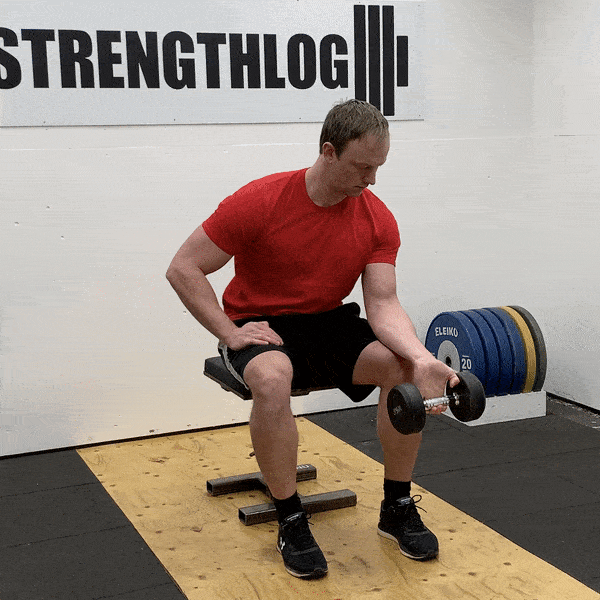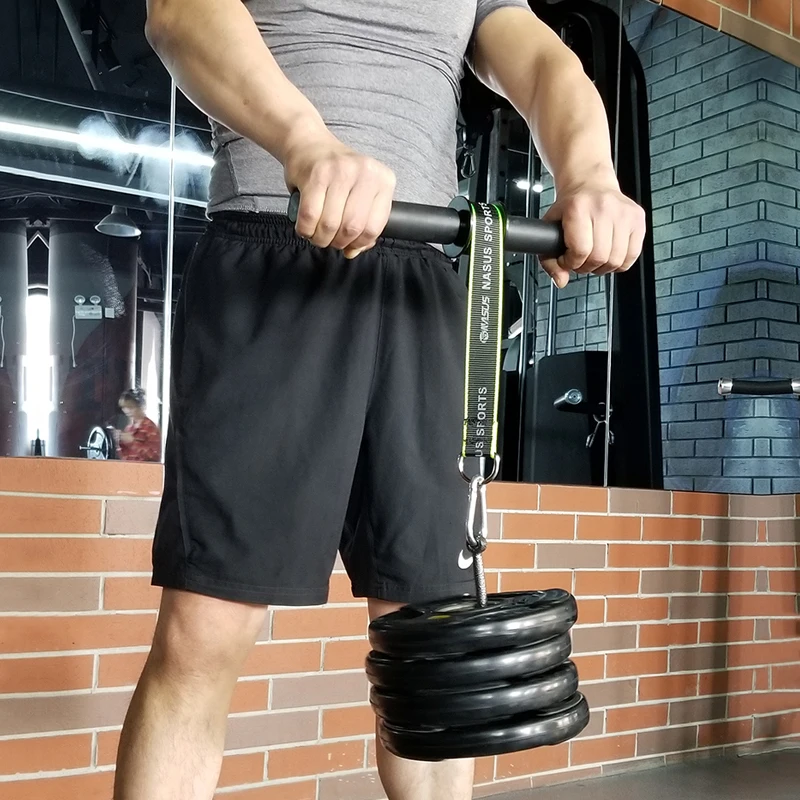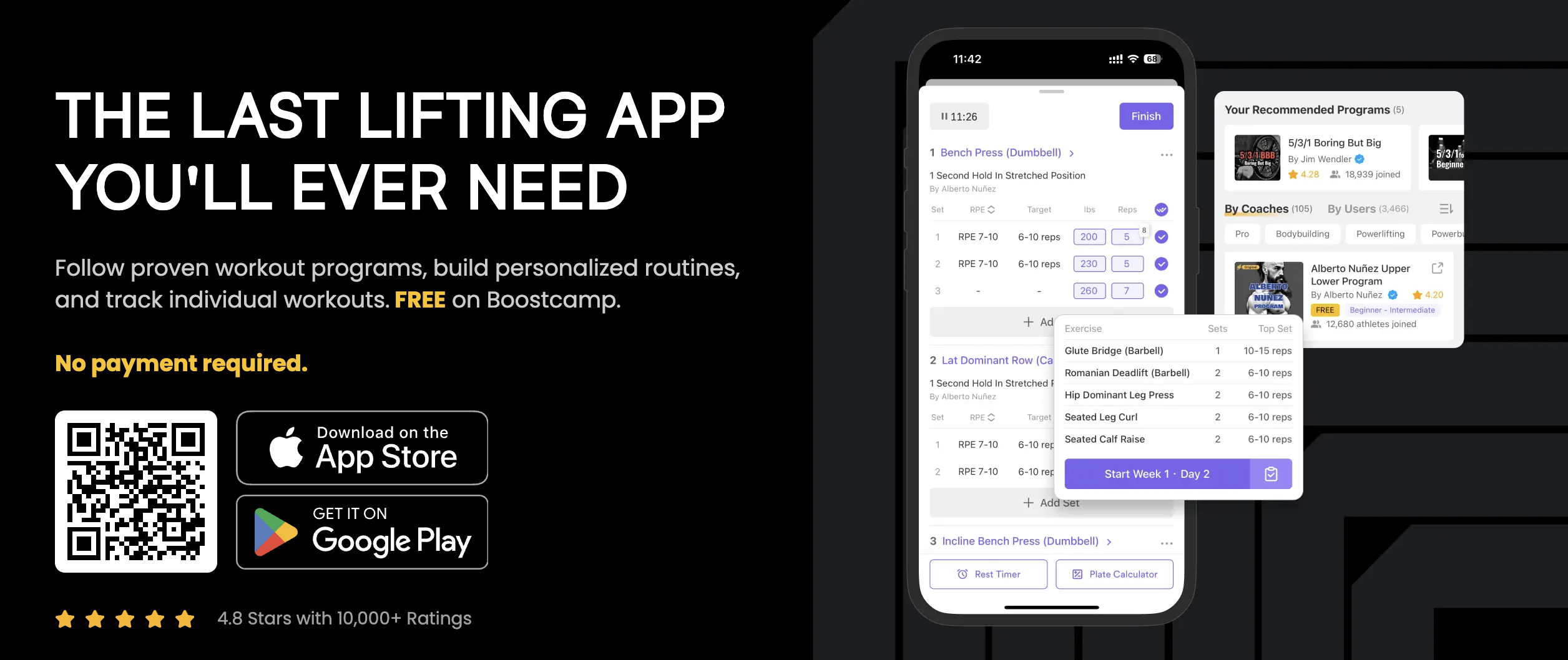The Best Forearm Workouts
Written by The Boostcamp Editors
The Best Forearm Workouts for Strength and Definition
Forearms are a tricky muscle to train, and if you're looking for the complete guide on training your forearms, this is it. Forearms are great for looks as well as functional strength (you activate your forearms every time you grip something) so building up strength and size in these muscles is key. In this guide our team at Boostcamp will help you to learn why you should train forearms (even if you already go the gym), how best to train your forearms (exercises and routines), and find the best forearm workout tools (dumbbells, household items, or specialty forearm tools).
That being said, let's dive in to the all things regarding forearm training.
Why Workout Your Forearms
Most people want to train their forearms for aesthetics, which is great. Getting bigger forearms make your arms look way more muscular. Imagine having huge biceps and triceps, but tiny forearms...how weird would that look? It is kind of like having big legs but no calves, meaning it just does not look right. Small forearms can bring the overall aesthetic of your physique down, while bigger forearms can give the illusion that your arms are bigger than they appear. Just look at Sylvester Stallone, his forearms are incredible in a shirt.
However, training your forearms is much more beneficial than just the appearance of the extra muscle mass, as they are essential in bodybuilding as well as powerlifting and other strength sports. Strong and defined forearms are essential for both functional strength and for hypertrophy. Not to mention, having a strong grip will help you with all of your upper body lifts, whether they be pulling or pushing movements. A strong grip helps you carry, hold, and lift items in your everyday life and during athletic activity. Plus, you’ll have more power when you work out, which will bring more strength to your entire body. If you want to get strong and add a ton of mass, you need to build powerful forearms. Your forearm workouts might seem like they have nothing to do with your leg workouts or back workouts, but having stronger forearms also allow you to build a stronger grip, which is essential to almost every pushing and pulling workout.
Here are some examples of exercises that strong forearms can be beneficial towards:
You might ask, "I already workout consistently in the gym, do I still need to do forearm-specific exercises?" That's a good question, and the answer is, it depends on your overall goals. If you think your forearms are small and an overall weak point, then you should absolutely train them for muscle growth. Sure, you indirectly train your forearms with things such as deadlifts and bicep curls, but it is very different than training them directly with forearm specific exercises for reps and progressive overload. This is why strongman training has many targeted forearm exercises...and guess what, strongmen have absolutely comical sized forearms. In fact, incorporating dedicated forearm work into your strength training split can provide additional stimulus and help you achieve even better results.
The Best Forearm Exercises
Now, we wouldn't tell you all about the importance of training forearms without actually diving into the best forearm exercises. Let's take a look!
Wrist Curls
This exercise is great for targeting the muscles on the underside of your forearms and improving your ability to perform daily tasks. Sit down on a bench and hold a kettlebell upside down, or a dumbbell, in each hand. Let your arms hang down at your sides with your palms facing up. From here, slowly curl your wrists upwards until your palms are facing your chest. Reverse the motion and lower the kettlebells back down to the starting position. A stronger grip helps you lift things, hold things, move things, and carry things with your hands and arms.

Source: https://www.strengthlog.com/
Reverse Wrist Curls
This exercise is similar to regular wrist curls, but it targets the muscles on the top of your forearm, rather than the underside. Sit down on a bench and hold a dumbbell in each hand. Let your arms hang down at your sides with your palms facing down. From here, slowly curl your wrists upwards until your palms are facing your chest. Reverse the motion and lower the dumbbells back down to the starting position. This exercise is great for building forearm strength and improving elbow flexion. Additionally, incorporating exercises like the dumbbell reverse curl can help target specific forearm muscles such as the brachioradialis and pronator teres, as well as the brachialis, which assists in elbow flexion.

Barbell Forearm Roll
This exercise is great for both forearm flexors and extensors. Grab a barbell with an overhand grip and stand up straight. Let the barbell hang down at arm's length in front of you. From here, roll the barbell up your forearms until it's resting on your biceps. Reverse the motion and roll the barbell back down to the starting position.

Source: https://www.strengthlog.com/
Farmer's Carries
This exercise is great for working your entire forearm, as well as your grip strength. Grab a pair of heavy dumbbells or a fully loaded hex bar and stand up straight. Let the dumbbells hang down at arm's length by your sides. From here, perform the farmer’s walk by walking forward while maintaining a tight grip on the dumbbells. Walk for a distance of 50-100 feet before turning around and walking back to the starting position.

Forearm Wrist Roller
This exercise requires a forearm roller and is a specific tool for forearm training. Hold the bar in front of you with the weights extended, then curl until the weights reach the top. This is a great tool, but not necessary to develop big forearms.

The Best Forearm Workouts
Forearm workouts if you already go to the gym
If you already go to the gym and follow a solid program with bench press, deadlift, pull-ups, and rows, then you can easily add in some forearm exercises at the end of your routine 1-2 times a week. We recommend doing 2-3 sets of 10-15 reps of either wrist curls, reverse wrist curls, or barbell forearm roll. You can also do farmer's walks as a finisher exercise–just pick a moderate weight and walk for 50-100 feet. When you’re training grip intensive exercises like chin-ups, deadlifts, bent-over rows, or carry variations, you will often feel your forearms burning. It’s usually the first muscle group to fatigue, so grip strength is often a weak point for lifters. When ripping a 500-pound deadlift off of the ground, it’s almost always your grip, not your lats, that gives out first. Additionally, incorporating hammer curl exercises into your routine can be beneficial for building your forearms and improving grip strength.
If you're not following a full body gym program, you absolutely should. After all, you don't want oversized forearms and weak everything else. Think of forearm training as adding bricks to your house, and a great workout program is the foundation of the home. You can find many free and science-based workout programs on Boostcamp App.
Forearm Workouts Without Weights
Forearm workouts if you don't go to the gym
If you don't go to the gym, or if you want to focus on building up your forearms specifically, then I would recommend doing a forearm workout routine 2-3 times a week. For each workout, start with 2 sets of 10-15 reps of either wrist curls, reverse wrist curls, or barbell forearm roll. Then move on to farmer's walks–again, pick a moderate weight and walk for 50-100 feet. Finally, end your workout with a forearm plank hold for 30-60 seconds.
If you don't have access to weights, no problem! There are still plenty of forearm exercises you can do to build strength. Try resistance bands, bodyweight exercises, or even household items like soup cans or jugs of water.
Bodyweight Forearm Exercises
Wrist Curls
Sit on the edge of a chair or bench and let your arms hang down at your sides with your palms facing up. From here, slowly curl your wrists upwards until your palms are facing your chest. Reverse the motion and lower your hands back down to the starting position.
Reverse Wrist Curls
Sit on the edge of a chair or bench and let your arms hang down at your sides with your palms facing down. From here, slowly curl your wrists upwards until your palms are facing your chest. Reverse the motion and lower your hands back down to the starting position. Coach’s Tip: It’s okay to flare your elbows a little bit if the movement pathway feels more natural for your limb length. Just make sure that the curl is being initiated by your biceps and supported primarily by your forearms.
Barbell Forearm Roll
Grab a broomstick or other long object and hold it with an overhand grip in front of you. Let it hang down at arm's length. From here, roll the barbell up your forearms until it's resting on your biceps, adding a grip challenge to the exercise. Reverse the motion and roll the barbell back down to the starting position.
Resistance Band Forearm Exercises
Band Wrist curls
Attach a resistance band to a sturdy object and loop it around your wrists. Sit on the edge of a chair or bench and let your arms hang down at your sides with your palms facing up. From here, slowly curl your wrists upwards until your palms are facing your chest. Reverse the motion and lower your hands back down to the starting position.
Band Reverse Wrist Curls
Attach a resistance band to a sturdy object and loop it around your wrists. Sit on the edge of a chair or bench and let your arms hang down at your sides with your palms facing down. From here, slowly curl your wrists upwards until your palms are facing your chest. Reverse the motion and lower your hands back down to the starting position.
Band Forearm Roll
Attach a resistance band to a sturdy object and grab it with an overhand grip. Let it hang down at arm's length. From here, roll the barbell up your forearms until it's resting on your biceps. Reverse the motion and roll the barbell back down to the starting position. To ensure proper form and maximize the benefits of this exercise, aim for 8 repetitions of the band forearm roll with a neutral grip. This will help you develop strong forearms and improve your grip strength.
Forearm Workout With Household Items
Makeshift Wrist Curls
Fill a soup can or jug of water with a desired weight and hold it in one hand. Sit on the edge of a chair or bench and let your arm hang down at your side with your palm facing up. From here, slowly curl your wrist upwards until your palm is facing your chest. Reverse the motion and lower your hand back down to the starting position.
Makeshift Wrist Curls
Fill a soup can or jug of water with a desired weight and hold it in one hand. Sit on the edge of a chair or bench and let your arm hang down at your side with your palm facing down. From here, slowly curl your wrist upwards until your palm is facing your chest. Reverse the motion and lower your hand back down to the starting position.
Makeshift Forearm Roll
Fill a soup can or jug of water with a desired weight and hold it in one hand with an overhand grip. Let it hang down at arm's length. From here, roll the barbell up your forearms until it's resting on your biceps. Reverse the motion and roll the barbell back down to the starting position.
Best Forearm Workout Tool
There are a lot of different forearm workout tools on the market, but honestly if you just use a dumbbell and barbell, it is more than enough to build amazing forearms.
If you really want a specific forearm workout tool, get a $20-$50 forearm wrist roller from Amazon and attach some weights to it.

Warmup
Before you start your forearm workout, it's important to do a proper warm-up. This will help avoid injury and ensure that your muscles are properly warmed up before you start working out.
One simple warm-up is to grab a light dumbbell and do some wrist curls and reverse wrist curls. Start with 3 sets of 10 reps and gradually increase the weight as you get more comfortable.
Another warm-up option is to attach a resistance band to a sturdy object and do some banded wrist curls and reverse wrist curls. Start with 3 sets of 10 reps and gradually increase the resistance as you get more comfortable.
Forearm Training Wrap Up
Overall, training forearms brings a load of benefits to the table, and not just aesthetic wise. Strong forearms will transfer over to your other lifts, which helps with your progression all around. Will you be trying any of these forearm workouts?
Be sure to follow Boostcamp on Instagram and subscribe on YouTube!

Header image courtesy of Instagram (@sam_sulek)

